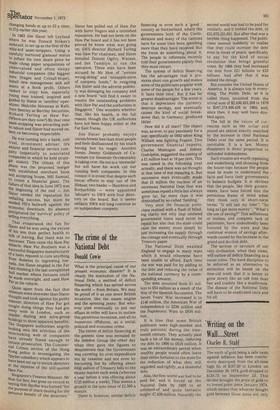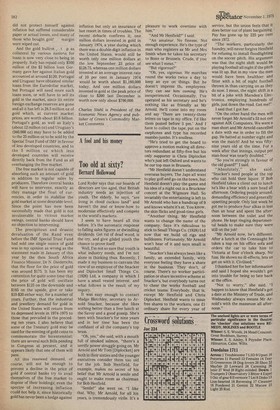'Writing on the Wall... Street
Charles R. Stahl
The myth of gold being a safe oasis against inflation has been conclusively destroyed: from the all-time high fix of $197.50 in London on December 30, 1974, gold dropped to $128.75 on September 23. This decline brought the price of gold to its lowest point since January 1974, which means that whoever bought gold between those dates not only did not protect himself against inflation but suffered considerable paper or actual losses, and many of those who bought gold • margin were wiped out.
And the gold bullion t p as collateral by various nations for loans is now very close to being in jeopardy. Italy has repaid only $500 million of the $2 billion loan Germany gave her against Italian gold accounted at around $120; Portugal and Uruguay have obtained similar loans from the Eurodollar market, but Portugal will need more such loans soon, or will have to sell its gold in the market, since its entire foreign exchange reserves are gone and all it has left is 28.5 million oz of gold which, at current market prices, are worth about $3.6 billion. Portugal's gold, as well as Italy's (about 12 million oz) and Uruguay's (940,000 oz) may have to be added to the 25 million oz to be sold by the Special Trust Fund of IMF in favour of less developed countries, and to the 5 million oz which less developed countries will receive directly back from the Fund as all overhanging the free market.
The free market is not capable of absorbing such an amount of gold in addition to regular sales by producers. Therefore central banks will have to intervene, exactly as they manage the float of currencies, in order to stabilise the gold market at some desirable level. Since the point has now been successfully made that gold is not invulnerable to vicious market swings, central banks should have no objection to intervening.
The precipitous and drastic devaluation of the Rand even before the IMF Special Trust Fund had sold one single ounce of gold was in my opinion as wrong as the statement made in January of this year by the then South Africa Finance Minister, Dr N. Diederichs, that the floor for the price of gold was around $175. It has been my contention for quite some time that the price of gold will oscillate between $125 on the downside and $185 on the upside, give or take $10-$20 either way, for a number of years. Further, that the industrial and jewellery demand for gold in the United States will return from its depressed levels in 1974-1975 to those that prevailed in the preceding ten years. I also believe that some of the Treasury gold may be used for the minting of gold coins to commemorate the bicentennial; there are several such Bills pending in Congress at present, and it appears likely that one of them will pass.
All this renewed demand, of course, will not be enough to prevent a decline in the price of gold if central banks try to avail themselves of the free market to dispose of their holdings; even the spectre of increasing inflation, could not help it, since historically gold has never been a hedge against inflation but only an insurance of last resort in times of troubles. The recent debacle confirms it; one million dollars invested in gold in January 1974, a year during which there was a double-digit inflation in the United States, would still be worth only one million dollars at the low September 23 price of $128.75, whereas one million dollars invested at an average interest rate of 10 per cent in January 1974 would be worth about $1,160,000 today. And one million dollars invested in gold at the peak price of close to $200 last December is worth now only about $700,000.
Charles Stahl is President of the Economic News Agency and publisher of Green's Commodity Market Comments

































 Previous page
Previous page